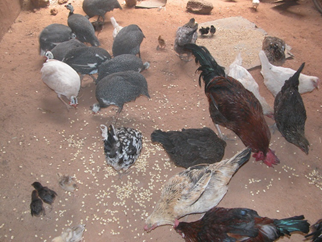Project in Burkina Faso
Intervention in Low Guinea Fowl Productivity and Related Products Consumption in Burkina Faso
Timeframe: June 2018 - September 2020
Funding: USAID
Principal investigator (PI) and lead institution
William S. Kisaalita, University of Georgia College of Engineering
Co-PI and collaborator institutions
- Alex Kojo Anderson, University of Georgia College of Family and Consumer Science
- Salibo Some, African Sustainable Development Council
- Salimata Pousg, Nazi Boni University Institute of Rural Development
- Aimé J. Nianogo, Nazi Boni University
Results
Kisaalita, W., 2020. Development engineering: Empowering the poor through sustainable technology-based solutions. Cambridge Scholars Publishing. (See 2022 article from University of Georgia, Professor’s new textbook addresses engineering solutions in low-resource settings)
Project Plan
 About 90% of the population in Burkina Faso and Niger engage in subsistence (smallholder) farming, living in small villages and farming communities, without access to grid electricity. One consequence of this fragility is stunting of children, an encompassing measure of chronic undernutrition. Increase in animal-source foods consumption has been identified as a viable solution. Increasing the scale of poultry farming among the rural poor, coupled with education to incorporate eggs and poultry meat in household diets and especially for children and their mothers, can be a potent solution to the endemic stunting problem.
About 90% of the population in Burkina Faso and Niger engage in subsistence (smallholder) farming, living in small villages and farming communities, without access to grid electricity. One consequence of this fragility is stunting of children, an encompassing measure of chronic undernutrition. Increase in animal-source foods consumption has been identified as a viable solution. Increasing the scale of poultry farming among the rural poor, coupled with education to incorporate eggs and poultry meat in household diets and especially for children and their mothers, can be a potent solution to the endemic stunting problem.
Objectives
We proposed to address the problem of low animal-source food consumption through expanded guinea fowl farming among smallholder households. We combined three established practices of:
- All year-round feeding of birds supplemented with fly larvae for increased productivity
- Synchronized hatching of guinea fowl eggs by chicken (Rakai Chicken Model, tested in Uganda), to produce many keets at once, yielding lower cost keets, among other advantages
- Low-cost evaporative cooling egg storage, while waiting for enough eggs to accumulate, for increased fertile egg viability.
Our two specific objectives were: 1) To produce fly larva and establish the optimum percentage of fly larva meal (protein) in guinea fowl diet growth and egg production; and 2) To establish the efficacy of integrating the three practices for year-round production of healthy keets.
Photo credit: W. Kisalita/UGA
More information
 October 2020 research update KISAALITA VGM (Virtual General Meeting)
October 2020 research update KISAALITA VGM (Virtual General Meeting)
- Fact sheet: Intervention in Low Guinea Fowl Productivity and Related Products Consumption
- French version: Amélioration de la productivité et de la consommation des produits
Feed the Future Innovation Lab for Livestock Systems is part of Feed the Future





